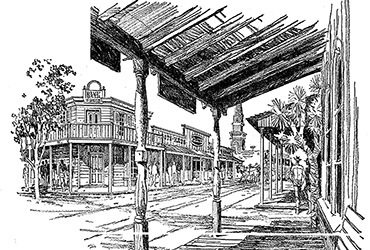Pioneertown High Desert Project

BY TOM CAMERON,
Times Real Estate Editor
To paraphrase the Scottish bard, if you take the high road and I take the low road, I’d be in Palm Springs or Palm Desert, while you’d find yourself in Yucca Valley on the high desert, or perhaps what has been dubbed “The Golden Empire” whose capital is picturesque Pioneertown.
Pioneertown is a familiar setting for scores of Western movies filmed in the jumbled rocks of the Morongo Range on the far side of the San Bernadino’s two hours from Los Angeles via the San Bernadino Freeway to the Yucca Valley, the 29 Palms turn off and on north to the unique community.
The place was built two decades ago in Old West style to be available as a complete movie set for Hollywood saddle spectaculars. They even called the principal thoroughfare “Mane St.” Hollywood responded, shooting some 50 films amid the false-front buildings and the nearby rocky or sandy terrain.
There was a modest real estate boom, too, but it didn’t amount to much, perhaps because of a lack of over-all planning and organization.
Things are different now.
Pioneertown is to be the heart of the so-called Golden Empire, a 30-square-area 4,000 ft. above sea level, and seldom subjected to excessive high temperatures, in which it differs from the low desert of the Coachella Valley, where 100-plus readings are common in the summer.
Benton Lefton, a former Cleveland developer who is head of the California Golden Empire, called in the experts to see how the area could be developed.
And, he told them, he didn’t have in mind another Disneyland or Knott’s Berry Farm, but rather a master-planned resort and residential community, Lefton refers to the Golden Empire as a $400 million project that by 1975 will have 18,000 single family home lots of from 7,200 square feet to two and one-half acres, and even some of up to 20 acres, depending on terrain. He plans 1,000 acres for condominium construction as well as town-houses and similar developments that might range up to 20 units per acre; 1,000 acres for commercial developments like shopping centers and hotels; 1,000 acres for church, school park, and recreational use, and even 1,000 acres for industry.
Lefton’s team consists of Ferdinand R. Iwasko, who prepared a master plan; William Snelling of Land Trends Inc., who did a feasibility study, and Jennings Engineering Co., who staked out the building sites, graded the roads and confirmed the master plan. The project is scheduled for 10 years of orderly development, according to Lefton.
From Cleveland
The developer was a major home builder in the Middle West for 20 years before coming here in 1961. He is a past president of the Home Builders Assn. of Greater Cleveland.
The first phase of development comprises 2,000 acres of the total of 21,000 acres and involves preparation of 15,000 lots. The civil engineering has been supervised by Gordon J. Jennings, head of the firm bearing his name.
“There is a minimum of grading involved,” Jennings said. “The natural desert beauty will not be scarred except in preparation of primary and secondary highways, access roads, and possibly some drainage control. Streets, curbs, gutters, and sidewalks are ready for paving. Utilities will be put in.
The first phase, in addition to some refurbishing of Pioneertown itself, involves about 10 acres for commercial zoning, 30 acres for trailer parks, 130 acres for multiple-unit residential development, and 1,650 lots ranging from small to large. Lots will be priced from $3,500 to $8,000. Multiple unit lots will be offered at $9,000.
Air Strip Planned
With its dry, clear atmosphere, Pioneertown will offer good facilities to the private flier. A 5,700-foot strip is being completed east of the town, with plenty of tie-down and other facilities.
There are about 20 commercial enterprises in Pioneertown now, and this number will be doubled by those under construction or scheduled, according to Lefton.
The California Golden Empire contains only about 100 homes today, but with steadily increasing popularity of the high desert—as exemplified by the tremendous growth of Yucca Valley, 29 Palms, Morongo Valley, Victor Valley and other nearly mile-high communities of the area—it should grow.
The inland high desert has no smog, and the scenery is impressive. Toward the coast there’s the big San Bernadino Mountain range, with majestic Mt. San Gorgonio (Old Greyback) thrusting 11,500 feet into the clear sky. To the north and south are vistas of the rugged hills with desert plants and distinctive Joshua trees. To the east, across the high desert mesas, are the distant mountains.
Source:
Posted: October 13, 2025

